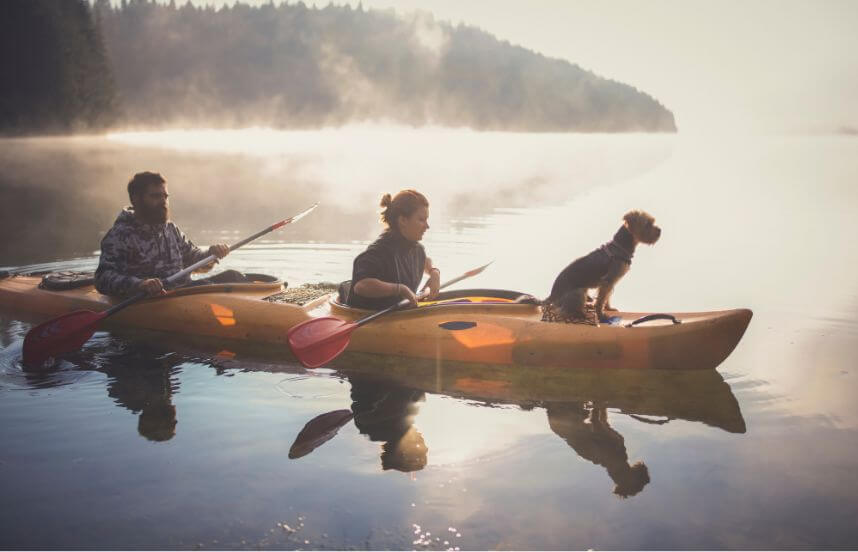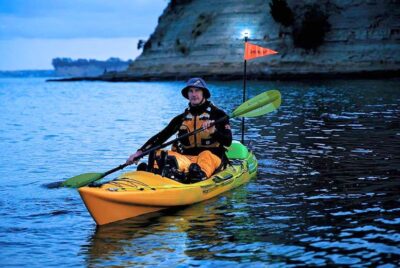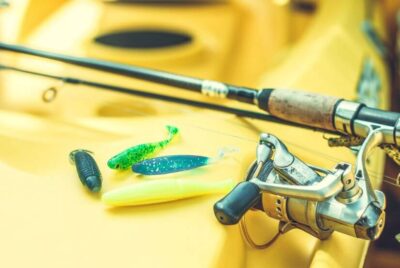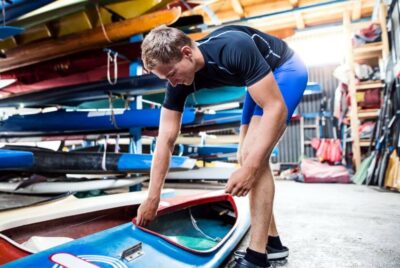An Essential Dog Kayak Guide: Paddling with Your Pup
Are you looking to combine two of life’s greatest joys—kayaking and spending time with your furry best friend? Then you’re in the right place. In this dog kayak guide, I’ll cover everything you need to know to make your kayaking adventures with your dog not just possible, but absolutely amazing.
Who This Guide Is For?
Who can benefit from this treasure trove of information? Honestly, anyone with a love for the water and a four-legged pal they would like to bring along for the ride. You may be a seasoned kayaker looking to make your weekend trips a family affair, including the doggo. Or perhaps you’re a beginner, just getting the hang of kayaking and thinking, “This would be so much cooler with my pup!” Whoever you are, this guide is designed to set you and your furry friend up for paddling success.
Why Kayaking with Dogs is Amazing
If you’ve ever felt the rush of gliding through water, wind in your hair, and the freedom of exploring uncharted territories, you’ll know there’s hardly anything that compares. Now, add to this the joyous face of your pup, tongue hanging out, eyes wide with excitement and wonder. That’s what dog kayaking is all about!
Imagine the sun kissing the water’s surface, creating a path of golden sparkles as far as the eye can see. You’re not just capturing this beauty alone; you’re sharing it with your dog. Whether it’s the peacefulness of a calm lake or the thrill of a fast-moving river, experiencing it with your dog adds another layer of excitement and bonding that’s unparalleled.

So, if you’re seeking adventure, bonding, and a new way to exercise and mentally stimulate your dog, kayaking provides an excellent option. It’s like turning an ordinary walk in the park into an epic quest of exploration and discovery. All of this is what makes kayaking with dogs an absolutely amazing experience.
Before You Get Started
Before we jump headlong into the kayak, it’s important to tackle some preliminary considerations. You wouldn’t go on a road trip without checking your car first, right? Similarly, you have to assess your dog’s swimming abilities and choose the appropriate kayak for a safe and joyful experience. Let’s get into the details.
Assessing Your Dog’s Swimming Skills
Before you even think about hopping into a kayak with your dog, it’s crucial to assess their swimming skills. Not all dogs are natural swimmers, and even those that are might need some getting used to the water. Here are some basic swimming skills that your dog should possess:
- Floatation: Your dog should be able to float in water without panicking. Floating is an essential skill as it helps the dog stay afloat when it accidentally falls into the water.
- Paddling: Check if your dog can paddle efficiently. Paddling is the dog’s version of swimming strokes and is necessary for them to move around in the water.
- Breathing Control: Pay attention to how your dog breathes while swimming. They should be able to control their breaths and not ingest water, which could lead to complications.
- Orientation and Navigation: Your dog should know how to change direction and head toward safety. If they can’t navigate in water, the risks of accidents increase.
- Confidence: Above all, your dog should be comfortable and confident in the water. A nervous dog can become a safety risk, for both the pet and the owner.
If your dog lacks in any of these areas, consider giving them some basic swimming lessons or consult a professional for training. Remember, safety first—for both you and your pup!
Choosing the Right Kayak
Picking the right vessel is more than just a choice; it’s a commitment to safety and enjoyment for both you and your furry friend. There are several crucial elements you should consider.
Size
When it comes to size, specific numbers can guide your choice, enhancing safety and comfort. Let’s get down to the nitty-gritty:
- Length: Kayaks generally range from 9 to 14 feet for solo paddlers. If you’re taking your medium to large-sized dog, aim for a kayak that is at least 12 feet long to accommodate both you and your pup comfortably. Longer kayaks (13-14 feet) are preferable for open water and extended trips.
- 9-11 feet: Best for smaller dogs under 30 pounds and ideal for short trips in narrower waterways.
- 12-14 feet: Suitable for medium to large dogs over 30 pounds and better for longer trips and open water.
- Width: The width of kayaks typically ranges from 24 to 30 inches. A kayak that is at least 28 inches wide will offer more stability and space. This is especially important if your dog likes to move around.
- 24-26 inches: Provides quicker movement but less stability. Recommended only for small dogs who are well-trained to sit still.
- 27-30 inches: Offers excellent stability and more room for your dog to move. This is ideal for larger dogs or those who might be a little more energetic.
- Storage: Make sure also to consider the weight capacity which usually ranges between 250-450 pounds for one-person kayaks. You’ll need a kayak that can carry both you, your dog, and any gear you plan to bring along.
Tip: Consider a shorter kayak for casual, leisurely outings or for more nervous pups. Opt for a longer kayak if you’re an experienced kayaker looking for speed and long-distance capabilities.
Stability
Stability is important when kayaking with your dog. There are a few key features to look for:
- Flat Bottom: Kayaks with flat bottoms generally offer more stability, making them a good choice for beginners or for those paddling in calm waters.
- Chines: These are the lines where the sides of the kayak meet the bottom. Soft chines make for a more stable kayak, while hard chines are better for maneuverability.
- Rocker: This is the curvature from the bow to the stern. Less rocker means better tracking but could compromise on stability.
- Testing: If possible, it’s always best to do a ‘test float’ with your dog to assess the kayak’s stability before making a purchase or rental commitment.
To ensure you and your pup are stable on the water, a simple solution would be to opt for a kayak anchor, one of the important kayak accessories.
Type
Understanding the types of kayaks available on the market will significantly influence your decision-making process. Here are some popular types and what they bring to the table:
- Sit-On-Top Kayaks: These are the most dog-friendly kayaks. They offer an open deck where your dog can sit comfortably, making it easier for both of you to get on and off. Great for casual paddling and calm water.
- Touring Kayaks: Designed for longer trips, these kayaks are sleek and long, offering more storage space. However, they usually have a closed cockpit, which might not be the best for larger dogs.
- Inflatable Kayaks: Extremely portable and generally more affordable, these kayaks can be a good option if you’re tight on storage space at home. However, they may not offer the same level of stability and are generally not recommended for larger or more active dogs.
- Fishing Kayaks: These come with extra storage and often have a broader, more stable base, making them good for dogs that like to move around a bit. They’re excellent for, well, fishing trips, but they can be on the heavier side.
- Tandem Kayaks: These kayaks have space for more than one person. If you have a larger dog or multiple dogs, a tandem kayak might be the right choice. Just remember that controlling a tandem kayak requires coordination between paddlers.
- Recreational Kayaks: These are short, wide, and stable, making them suitable for beginners and calm waters. They usually have a large open cockpit, making it easier for your dog to get in and out.

Essential Gear for Dog Kayaking
Preparing for a kayaking adventure with your dog is different from packing for a solo trip. Dogs require their own set of gear to ensure they are safe, comfortable, and having fun. Here’s a breakdown of essential items you shouldn’t overlook.
Life Jackets
Yes, even if your dog is an expert swimmer, a life jacket is non-negotiable. Dogs can tire easily, and if you’re far from the shore, that’s a risk you don’t want to take.
- Proper Fit: Make sure the jacket fits snugly but doesn’t restrict movement. Most have adjustable straps for a customized fit.
- Handle: Choose a jacket with a sturdy handle on top. This makes it easier to lift your dog back into the kayak if they decide to take an unplanned swim.
- Bright Colors: Opt for bright colors like orange or neon green to make it easier to spot your dog in the water.

Dog-Friendly Paddles
When you’re out kayaking with your furry friend, the last thing you want to worry about is whether your paddle will accidentally harm your pet or make your adventure more challenging. That’s why it’s essential to select the right kind of paddle. Here’s a detailed guide on what to look for in a dog-friendly paddle:
- Smooth Edges: Let’s start with the basics; your paddle should have smooth, rounded edges. You might not think your paddle’s edges are a big deal until your excited dog gets close to it and potentially gets scraped or cut. Many high-quality paddles come with rounded corners as a safety feature—just check the specifications before you purchase.
- Lightweight but Durable: A lightweight paddle, preferably one made of carbon fiber or a carbon blend, will give you the control you need if your dog decides it’s playtime. Lightweight doesn’t mean fragile, though. Make sure it’s durable enough to withstand the occasional doggy paddle or excited jump from your canine companion.
- Non-Slip Grip: Dogs can get excited, and their movements might shake the kayak. A paddle with a non-slip grip ensures that you keep control of the kayak regardless of your dog’s antics. Look for grips made of foam or with ergonomic designs that mold to your hand for the most effective control.
- Blade Design: The blade design can also be crucial when you’re kayaking with your dog. A dihedral blade design, which features two planes that meet at a ridge down the center, can make for smoother and more stable strokes, thus making it less likely that you’ll accidentally jerk the paddle into your dog.
- Length: Consider the length of the paddle in relation to where your dog will be sitting. You’ll want a paddle long enough to easily maneuver around your dog but not so long that it becomes unwieldy.
- Noise Level: This may seem like a minor point, but some paddles are designed to minimize splashing and are, therefore, quieter when they slice through the water. A quieter paddle might be less likely to spook a nervous pet who is new to the kayaking experience.
- Material Matters: Earlier, we touched on carbon fiber and fiberglass materials. These materials offer the advantage of being both lightweight and robust. They are also generally more “forgiving” regarding bumps and nicks, making it less likely they’ll cause injuries if they come into contact with your pet.
First Aid Kit
Even if you take all the precautions in the world, accidents can happen. A dog-specific first aid kit should be part of your kayaking gear.
- Bandages and Gauze: For any cuts or injuries.
- Tweezers: Useful for removing thorns, or heaven forbid, fish hooks.
- Pet-safe Antiseptic: To clean wounds immediately.
- Contact Information: Keep a card with your vet’s contact information and any important medical history regarding your dog.
Preparing Your Dog
Before you hit the water with your furry friend, there are some preparatory steps that are crucial for a successful outing. These include obedience training and practice runs. Skipping these could mean the difference between a memorable experience and a disastrous one.
Obedience Training
Proper training is essential for a safe and enjoyable kayaking trip. You’re essentially teaching your dog how to be a good “co-pilot,” and it starts with basic obedience training.
- Basic Commands: Teach your dog the basics like “Sit,” “Stay,” “Come,” and “No” if they haven’t already learned them.
- How to Train: Use treats and positive reinforcement. Say the command, guide your dog into the position, and then reward with a treat and praise.
- Quiet on Command: You need to be able to control your dog’s vocalizations on the water.
- How to Train: Start at home by saying “Quiet” when your dog barks, and rewarding them with a treat when they stop. Gradually extend the time they must remain quiet to earn the treat.
- Leave it/Drop it: This skill can prevent them from picking up something harmful or unsettling the kayak.
- How to Train: Place a treat in both hands. Show them one hand and say “Leave it.” Wait for them to stop sniffing or pulling towards your hand, then reward them with the treat from the other hand.
- Heel: This helps you keep your dog close during key moments, like boarding or disembarking.
- How to Train: Walk your dog on a leash and use the command “Heel” to indicate you want them by your side. Reward with treats for compliance and slowly introduce distractions to keep the behavior.
Practice Runs
Practice makes perfect. Here are detailed steps to acclimate your dog to a kayak.
- Start on Dry Land
- Step 1: Place the kayak in your yard and let your dog sniff around it. This helps to familiarize them with this new object.
- Step 2: Sit in the kayak and invite your dog to join you. Use treats and positive reinforcement.
- Shallow Water Trials
- Step 1: Move the kayak to a calm, shallow area of water. Place your dog in the kayak while it’s still on land, then gently slide into the water.
- Step 2: Keep these initial outings short, say about 5-10 minutes, and gradually increase as your dog becomes more comfortable.
- Add Some Motion
- Step 1: Start to paddle slowly, taking care to make gentle turns.
- Step 2: Observe your dog’s reactions. If they seem nervous, it may be helpful to have a second person to soothe and distract them initially.
- Simulate Real Conditions
- Step 1: As your dog becomes more comfortable, start to mimic the conditions of a real kayaking trip. This could mean moving into deeper water or paddling for longer distances.
- Step 2: Use this time to adjust your setup, including securing any loose gear and ensuring your dog’s life vest fits snugly.
While On The Water
Now that you’ve prepared your dog and equipped yourself with the essential gear, it’s time to actually get out there on the water. As exhilarating as it is, remember that safety comes first, but there’s also room for some canine-friendly fun.
Safety Tips
Being on the water introduces a new set of variables that you need to prepare for. Here are some safety tips to consider:
- Stay Close to Shore: On your first few outings, stay close to the shore where the water is calmer, and help is more readily accessible.
- Watch the Weather: Always check the weather forecast before heading out. Sudden weather changes can make kayaking with a dog difficult and dangerous.
- Hydration is Key: Just like humans, dogs need to stay hydrated. Make sure to pack enough water for both of you.
- Avoid High Traffic Areas: Stay clear of busy areas where there are lots of boats, jet skis, or swimmers that might stress your dog or create dangerous conditions.
- Have a Rescue Plan: In the unlikely event that your kayak capsizes, have a plan. Know how to quickly release your dog from any restraints and how to re-enter your kayak.
Fun Activities
Kayaking can be more than just a paddle along a water trail; it can also include engaging activities to make the experience even more enjoyable for you and your furry friend.
- Floating Fetch: If your dog loves fetch, bring along a water-friendly toy that floats. Make sure you’re in a safe, shallow area, and toss the toy a short distance away from the kayak for your dog to retrieve.
- Island Exploration: If you’re kayaking in an area with small islands or sandbars, take breaks to explore these mini-landscapes. It’s a great way for your dog to stretch their legs and for you to enjoy some on-foot exploration.
- Wildlife Watching: While it’s essential to keep a safe distance, kayaking can be a great way to observe wildlife. Turn it into a game by asking your dog, “What’s that?” every time you see a bird or fish, and reward them for their interest.
- Photography: Capture the memories! Dogs are excellent photography subjects, and the backdrop of water and nature will make for some frame-worthy shots. Just make sure your camera is water-resistant or protected.
- Picnic Time: Pack some snacks for both you and your dog, and have a picnic on the water. Make sure to pack the food in waterproof containers and keep human and dog food separate.
Conclusion
Taking your dog kayaking can be a truly unforgettable experience that strengthens the bond between you and your four-legged friend. Whether you’re both new to kayaking or seasoned pros, there’s always something new to discover when you’re out on the water together. From choosing the right kayak to understanding essential safety measures, preparation is key. And don’t forget to have fun—after all, that’s what this incredible adventure is all about!
Whether you are looking for a unique workout, a way to relax, or simply a means to explore nature, kayaking with your dog covers all these bases and more. It’s not just about the destination; it’s about the journey you share with your furry pal. Happy paddling!
FAQs
Q: How do I manage bathroom breaks for my dog during kayaking trips?
A: Plan your route to include stops at dog-friendly beaches or shallow areas where you can let your dog out to do their business. Always bring waste bags to clean up after your dog.
Q: What do I do if my dog gets anxious or scared while on the kayak?
A: It’s crucial to monitor your dog’s behavior throughout the trip. If your dog seems anxious, it might help to anchor for a bit and comfort them. Always have a favored toy or treat on hand as a familiar comfort. If your dog doesn’t settle, it may be best to cut the trip short for their well-being.
Q: Is it safe to kayak in the ocean with my dog?
A: Kayaking in the ocean presents more challenges, including tides and waves. It’s recommended for more experienced kayakers and dogs who are very comfortable in the water.
Q: Can I take more than one dog kayaking?
A: This largely depends on the size of your kayak and your dogs. It’s possible but requires more advanced planning and attention to safety.
Q: How can I ensure my dog stays hydrated while kayaking?
A: Always bring fresh water and a collapsible bowl for your dog. Some dogs may try to drink from rivers or lakes, but this can be dangerous due to possible pollutants or parasites. Regularly offer your dog water to make sure they stay hydrated.





